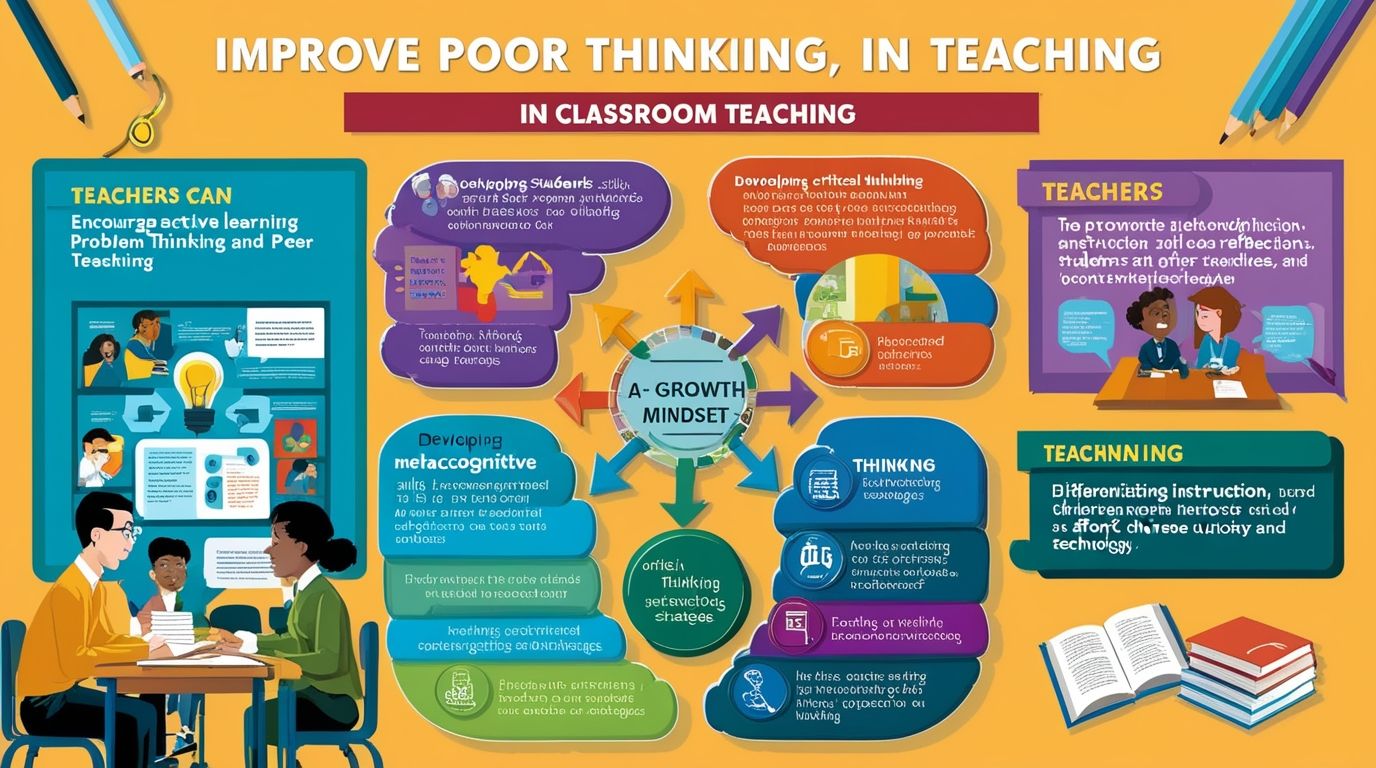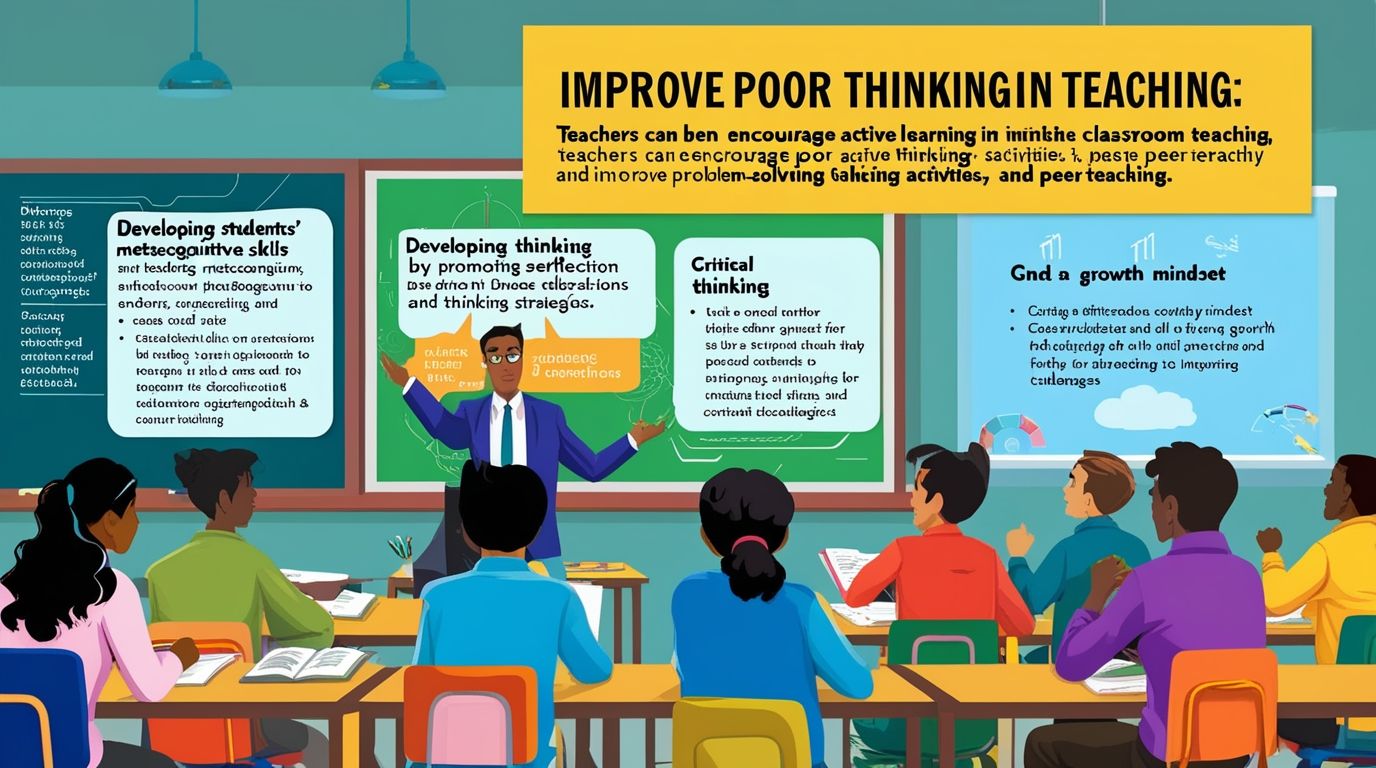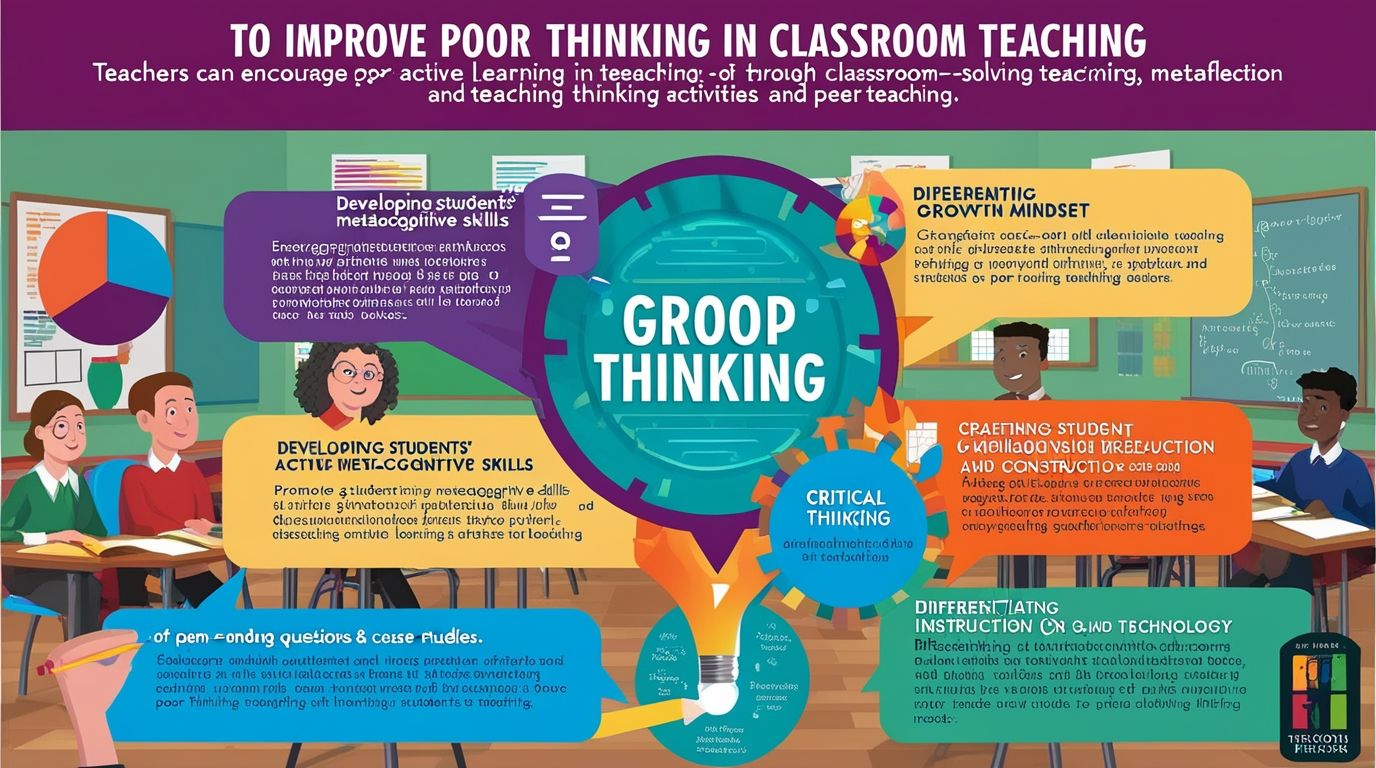How to Improve Poor Thinking in Classroom Teaching, Effective thinking is essential for students’ learning and understanding in the classroom. However, many students struggle with poor thinking, which hampers their academic progress and ability to engage meaningfully with content. Poor thinking can manifest in many ways, including lack of critical analysis, difficulty in solving problems, reliance on rote memorization, and a passive approach to learning. This article explores strategies that teachers can implement to enhance student thinking and foster deeper cognitive engagement during classroom teaching.
Understanding the Causes of Poor Thinking
Before implementing strategies to improve thinking, it’s crucial to understand the underlying causes of poor thinking. Some common reasons include:
- Lack of Motivation: If students are not motivated to engage with the content, their thinking becomes superficial, leading to poor cognitive engagement.
- Over-reliance on Memorization: In some classrooms, the focus may be on rote memorization rather than on developing understanding and problem-solving skills. This can limit students’ ability to think critically and creatively.
- Insufficient Practice of Thinking Skills: Students often lack practice in higher-order thinking skills, such as analysis, evaluation, and synthesis, which are necessary for deep understanding.
- Teacher-Centered Instruction: In teacher-centered classrooms, students may become passive learners, simply absorbing information without the opportunity to engage in active thinking processes.
Strategies to Improve Thinking in Classroom Teaching
To address poor thinking, teachers must create an environment that promotes active thinking and critical engagement. Below are some strategies teachers can adopt:
1. Encourage Active Learning
Active learning requires students to actively participate in the learning process, which enhances their thinking and problem-solving abilities. Teachers can foster active learning by:
- Incorporating Discussions: Discussions encourage students to express their thoughts and opinions, promoting critical thinking. Socratic questioning, for example, encourages students to evaluate their understanding and question assumptions.
- Problem-Based Learning (PBL): In PBL, students are presented with complex, real-world problems that require them to apply critical thinking, collaboration, and creativity to solve. This promotes deeper cognitive engagement as students must analyze and evaluate information rather than simply recall facts.
- Peer Teaching: When students teach each other, they must think critically about the material to explain it clearly, which strengthens their understanding and cognitive skills.

2. Develop Metacognitive Skills
Metacognition, or thinking about one’s thinking, is an essential skill for improving thought processes. It helps students become aware of their own learning and enables them to regulate their cognitive strategies. Teachers can help students develop metacognitive skills by:
- Encouraging Self-Reflection: After completing assignments or assessments, students should reflect on what they did well and what they can improve. Teachers can guide this process by asking reflective questions, such as, “What strategies did you use to solve this problem?” or “How could you approach this task differently next time?”
- Teaching Thinking Strategies: Direct instruction in thinking strategies, such as summarizing, predicting outcomes, questioning, and connecting ideas, helps students to process information at a deeper level. Teachers can model these strategies during instruction and provide opportunities for students to practice them.
3. Promote Critical and Analytical Thinking
Critical thinking involves evaluating information and arguments, identifying biases, and considering multiple perspectives. Analytical thinking breaks down complex information into manageable parts for better understanding. To promote these skills, teachers can:
- Use Open-Ended Questions: Asking open-ended questions that require analysis, synthesis, and evaluation encourages students to think deeply. For example, instead of asking, “What is the capital of France?” teachers can ask, “Why do you think Paris became the capital of France?”
- Integrate Case Studies: Case studies allow students to analyze real-world scenarios and make decisions based on evidence. This fosters both critical and analytical thinking as students must weigh various factors and consider different perspectives.
- Teach Logical Reasoning: Logical reasoning helps students understand cause-and-effect relationships, identify fallacies, and draw sound conclusions. Teachers can introduce logic puzzles, debates, and argument analysis to develop these skills.
4. Foster a Growth Mindset
A growth mindset—the belief that intelligence and abilities can be developed through effort—promotes resilience, persistence, and a willingness to engage in challenging tasks. A fixed mindset, on the other hand, leads to avoidance of difficult tasks and a belief that intelligence is static. To foster a growth mindset, teachers should:
- Praise Effort, Not Intelligence: Instead of praising students for being “smart,” praise them for their effort and perseverance. This encourages them to embrace challenges and view mistakes as learning opportunities.
- Normalize Struggle: Teachers can help students understand that struggling with difficult tasks is a normal part of learning. Sharing personal experiences of overcoming challenges or showcasing examples of famous figures who succeeded after failure can be motivational.
- Provide Constructive Feedback: Feedback should be specific and focused on areas for improvement, rather than on judgment. Teachers can offer strategies for how students can improve, which helps them understand that growth is possible.
5. Differentiate Instruction to Meet Diverse Thinking Needs
Not all students think and learn in the same way. Differentiated instruction allows teachers to meet the diverse cognitive needs of students by providing a variety of learning opportunities. Strategies include:
- Tiered Assignments: Offering assignments at different levels of complexity ensures that all students are challenged appropriately. For example, one group of students might analyze a text for main ideas, while another group analyzes the author’s use of literary devices.
- Choice-Based Learning: Giving students choices in how they demonstrate their learning encourages ownership and deeper engagement. For example, students could choose to write an essay, create a presentation, or build a model to demonstrate their understanding of a topic.
- Flexible Grouping: Grouping students by interest, ability, or learning style allows them to collaborate with peers in ways that complement their thinking. Teachers can vary group compositions to expose students to different perspectives and cognitive approaches.

6. Integrate Technology to Enhance Thinking
Technology can be a powerful tool to enhance thinking in the classroom when used effectively. Digital tools can provide students with access to a wealth of information and resources that support critical thinking. Some ways to integrate technology include:
- Online Simulations and Games: Educational games and simulations can provide students with opportunities to explore complex systems, test hypotheses, and make decisions in a safe environment. This promotes both critical and creative thinking.
- Collaborative Platforms: Tools like Google Docs, Padlet, and discussion forums encourage students to collaborate, share ideas, and provide feedback to one another. This type of collaboration fosters deeper thinking and helps students learn from each other’s perspectives.
- Research Tools: Teaching students to use online databases, citation tools, and research software can improve their ability to gather, evaluate, and synthesize information from multiple sources.
7. Create a Classroom Culture that Values Thinking
The classroom environment plays a critical role in shaping students’ thinking habits. A classroom culture that values curiosity, inquiry, and risk-taking promotes deeper thinking. Teachers can cultivate such a culture by:
- Encouraging Curiosity: Allowing students to ask questions and explore topics of interest fosters a love of learning and intellectual curiosity. Teachers can set aside time for inquiry-based learning or use students’ questions to guide lessons.
- Modeling Thinking: Teachers should model the thought processes they want students to use, whether that’s reasoning through a problem, making connections between ideas, or reflecting on their learning.
- Valuing Mistakes: Mistakes should be viewed as learning opportunities. Teachers can help students reframe mistakes as valuable steps in the learning process, which encourages a willingness to take intellectual risks.
Conclusion
Improving poor thinking in classroom teaching requires intentional strategies that promote active engagement, critical and analytical thinking, and a growth mindset. Teachers play a pivotal role in shaping how students think by creating learning environments that challenge them to go beyond rote memorization and engage with content at a deeper level. Through active learning, metacognitive development, and differentiation, students can develop stronger cognitive skills that will serve them not only in the classroom but throughout their lives. By valuing the process of thinking and encouraging intellectual curiosity, teachers can help students become confident, independent thinkers capable of tackling complex problems.
References
- Brookhart, S. M. (2010). How to Assess Higher-Order Thinking Skills in Your Classroom. ASCD.
- Costa, A. L., & Kallick, B. (2008). Learning and Leading with Habits of Mind: 16 Essential Characteristics for Success. ASCD.
- Marzano, R. J. (2007). The Art and Science of Teaching: A Comprehensive Framework for Effective Instruction. ASCD.
- Dweck, C. (2006). Mindset: The New Psychology of Success. Random House.

6 thoughts on “How to Improve Poor Thinking in Classroom Teaching”
Comments are closed.